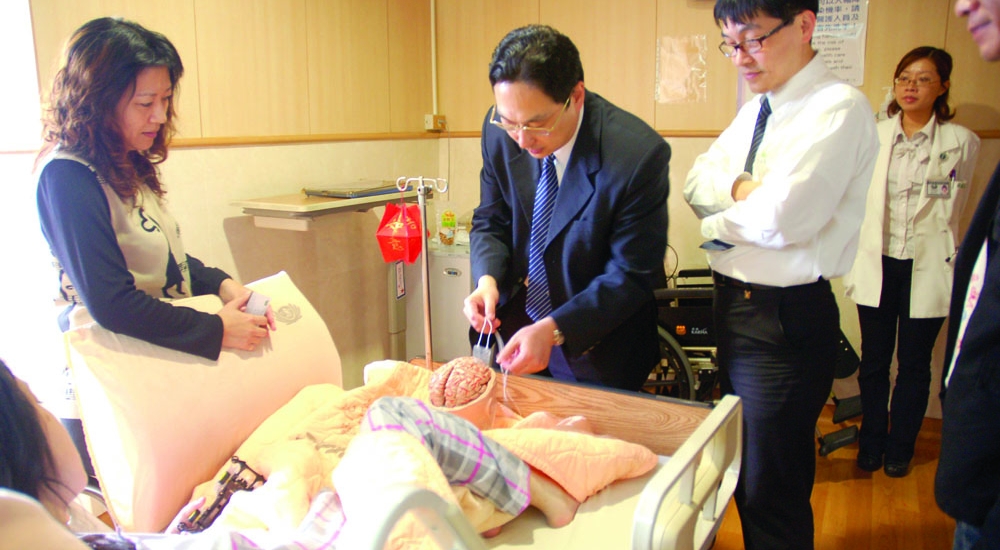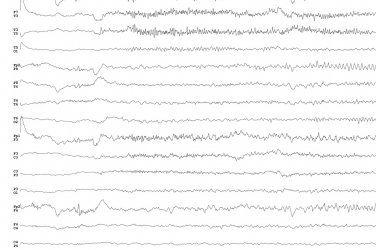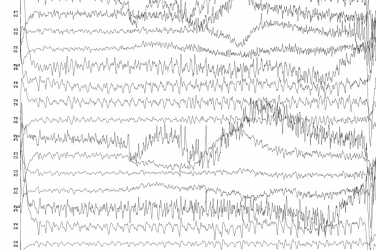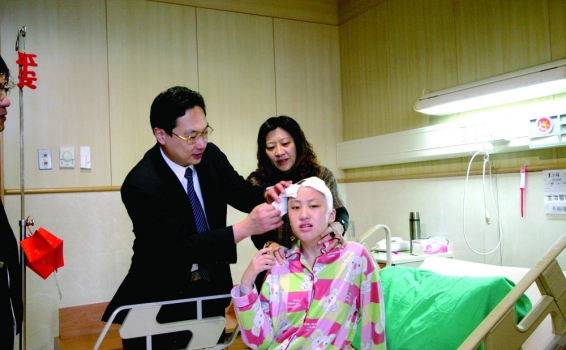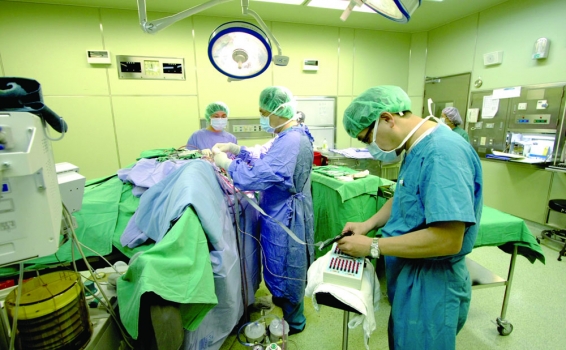Reaching a New Milestone for Treating Epilepsy
Epilepsy, from the Greek word epilambanein, means “a condition of being overcome, seized, or attacked”.
Epileptic patients suffer from an abnormal electrical discharge by a group of brain cells, causing drastic changes in consciousness, movement and feeling.
Surprisingly, many famous artists, writers and leaders like Beethoven, Guy de Maupassant, Vincent van Gogh, Julius Caesar, Alexander the Great, and Napoleon all had epilepsy.
Currently, about 200,000 people suffer from epilepsy in Taiwan.
People are stereotyped with this disease, and it often strikes at night when family members are least prepared.
In order to give proper respect to patients, the medical community in Taiwan officially named the disease “epilepsy” (a direct translation from the English medical term) in 2007.
In 2003, Hualien Tzu Chi General Hospital established an Epilepsy Treatment and Research Center.
With astonishing discoveries and award winning research, the center established an inter-institutional neuroscience taskforce with the National Chiao Tung University in September of 2010.
Combining science, biology and medicine, the team invented the chipsets to analyze the problem area, its location and cycle; and found the root source to terminate misfired electrical signals – a cure for epileptic patients...
Written by Si-Chi Huang
When Xiaojian was four-yearsold, one night after she’d gone to sleep for ten minutes, she sat up and her eye balls started twitching to the side. We knew right away that there was something wrong with her.”
Even today, whenever Xiaojian’s parents recount Xiaojian’s first episode, they still tremble in fear.
Like many other children, Xiaojian was very active and happy, and did not experience any problem in language ability or physical development. The experience was so scary to her parents that they started seeking doctors right away. After many doctor visits and checkups, it was confirmed that Xianjian had epilepsy.
Sudden and Violent Seizures that Occur in the Sleep
After taking medication on a regular basis, Xiaojian’s condition improved. This gave Xianjian’s parents a lot of hope that Xiaojian might be better as time passed. However, when Xiaojian was almost sixyears-old, her symptoms worsened with breathing difficulty. After several changes in prescription, her condition did not improve; instead it became more apparent that her eyes were twitching to the side.
“At the beginning, every time when she was short of breath, we panicked and didn’t know what to do. After we called the emergency, we cried all the way in the ambulance to the hospital and begged them to save our daughter.”
Both Mr. and Mrs. Kao quit their jobs to take care of Xiaojian. Not only did they learn about first aid, they also prepared an oxygen tank and CPR emergency kit at home and in the car. In addition, they developed their own method in delegating first-aid procedures when an attack strikes. For example, one would be responsible for grabbing the oxygen tank and the other would record the details of the attack. They kept track of the times and symptoms in order to report back to her team of doctors.
“It is not the epileptic seizure that we are afraid of but the chain reaction that comes with it.”
Epilepsy is unpredictable and there is no way to predict when it will occur, even though many cases have been linked to sleep. So whenever it does occur, it often results in some accidents not only for the patients but the people around them.
One patient who is about 1.9 m in height and about 140 Kg in weight ended up hurting himself because his parents could not and would not help for fear getting injured themselves. Kids like Xiaojian often are victims of cuts and bruises from the fall during an attack. Some patients even break their teeth or bones.
Epilepsy often occurs at night and right after patients fall asleep. This seriously damaged the quality of Xiaojian’s sleep. As a result, Xiaojian’s parents were also afraid of “sleeping”. For the first ten years, Xiaojian’s family couldn’t have a good night sleep. Not until 2006, when Mrs. Kao watched a TV program about how doctors and nurses from the Neuroscientific Medical Center of Hualien Tzu Chi General Hospital helped epileptic patients to find normal life, did she decide to take Xiaojian to seek treatment at the Hualien Tzu Chi Medical Center.
Micro Chips Precisely Identifies and Removes the Abnormal Discharge
“At that time, Dr. Hsin recommended us to check into the hospital right away and asked us if we needed to go home and pack. Without any hesitation, we told him we were ready to check in at any time because we had our luggage with us!”
“The first night after she checked into the hospital, Dr. Hsin made some adjustment to Xiaojian’s prescription. I found that she fell asleep like other normal kids.”
This was the first step towards a cure. It brought hope to Xiaojian’s parents.
Dr. Yue-Loong Hsin, a neurologist from Hualien Tzu Chi Medical Center, examined thoroughly Xiaojian’s brain and nervous system. Based on her past history, Xiaojian had no known brain injury and her condition was not due to hereditary or infection causes. However, she did have convulsions and it also affected her behavior and learning. She was diagnosed with “idiopathic epilepsy” – epilepsy with no apparent cause. In other words, her epilepsy cannot be controlled by medication, so surgery was her last and only option.
Epilepsy Introduction
Epilepsy, from the Greek word epilambanein, means "a condition of being overcome, seized, or attacked." Epileptic patients suffer from an abnormal electrical discharge by a group of brain cells. The symptoms include sudden dysfunction in consciousness, movement and feeling. Currently there are approximately twenty types of symptoms. The cause of the illness cannot be determined in approximately forty percent of the patients. The majority of which is due to head injuries either during birth or external force, stroke, or tumors. Approximately 80 percent of the epileptic patients can be controlled by medication – to reduce recurrence of the epilepsy.
After Dr. Yue-Loong Hsin discussed her case with Dr. Tomor Harnod, a neurosurgeon, they recommended a corpus callosotomy to relieve her convulsions and avoid other damage that could be caused by convulsions. In 2008, Xiaojian’s parents decided to undergo this surgery to disconnect the cerebral hemispheres. This surgery would make it harder to send messages between the two hemispheres.
“Even though doctors said it was a small surgery, it had a major impact on Xiaojian – it stopped Xiaojian’s convulsion for almost ten months. And we didn’t even need to use oxygen tanks.”
While they felt relief about Xiaojian’s condition, Xiaojian had another episode right after she started attending junior high school in 2010. The sudden recurrence of the seizures caught Xiaojian’s parents by surprise. The epilepsy team quickly arranged a checkup to confirm whether there was a need to perform a lesionectomy, a removal of a focal or hemispheric lesion to control seizures.
Dr. Hsin said an epileptic patient would have a lifetime risk of epilepsy recurrence. Hardly any patient can be cured or live without any medication for life. Removal of the focal lesion of the brain is still an injury to the brain, but the removal of that focus lesion can help control the seizures; therefore the removal is the best option for the patient. To a surgeon, precise identification of the source of the seizures and the surgical removal of lesions are equally important because it can cause permanent neurological damage.
“I am a surgeon, the patient is my best teacher, but I know I do not have much time to do research and perform experiments,” said Dr. Hsin.
Dr. Hsin, along with many doctors, believes that doctors, the guardians of life, should not limit their duties in the hospital setting. Their ultimate goal is to provide the best and most appropriate medical services to patients. So Hualien Tzuchi General Hospital Neurological Science Center partners with National Central University, National Chiao Tung University and National Cheng Kung University to establish an interdisciplinary and inter-institutional taskforce. They share resources and experience to develop a system, which uses a computerized electrical device implanted in the skull to better identify the abnormal discharge of the brain cells and to collect data. The better the data collection process is, the better the team can predict the recurring of epilepsy and to precisely locate the epileptic foci. Furthermore, by precisely locating the epileptic foci, it can reduce the impact of damage due to surgery. Xiaojian is the first patient to utilize this system to localize her epileptic foci.
“We believe in Dr. Hsin and Dr. Harnod.”
After more than four years of interaction with the epileptic team, Xiaojian’s parents have established a good working relationship with the team. When they heard that Xiaojian might need another surgery, they didn’t go through much struggle before agreeing to the surgery. They knew Xiaojian’s surgery is not just to improve her condition, but the knowledge that the epileptic team learns from Xiaojian would help more kids with similar conditions for more effective treatment.
Living with a Lifelong, Controlled Illness
When a patient experiences a seizure, he or she might be injured from the movements at a state of unconsciousness. The frequent recurrence of the illness can cause sleep disorder and affect learning ability. Dr. Hsin pointed out that from an epidemiological point of view, 100 out of 100,000 people have epilepsy, which means among the 23 million people in Taiwan over 150,000 people have epilepsy. Even though epilepsy affects many people, it is not drawing much needed attention compared to tumor or cancer, because epileptic patients do not have a high mortality rate. Epilepsy is a life-long problem affecting both patients and family members.
More importantly, the majority of the public has a misconception about epilepsy and even the epileptic patients themselves do not have good understanding of their illness. Patients are often misinformed, discriminated against and not given the equal opportunity for job opportunities, education and job training. Some people even think epilepsy is a psychological illness. In fact, the epileptic patient is not different from a regular person. They can go to school, work, make friends and get married. To encourage epileptic patients and family members, Dr. Hsin often cites his first “lesionectomy” patient who is now married and have children, living a normal life and without the need for medication.
Xiaojian has had no recurrence of epilepsy for more than half-a-year since the surgery. Her language ability, attention span and right limbs’ flexibility are getting better after physical therapy. Xiaojian’s parents still sleep with their child at night, but witnessing her improvement in physical condition and learning ability is the happiest thing to them.

